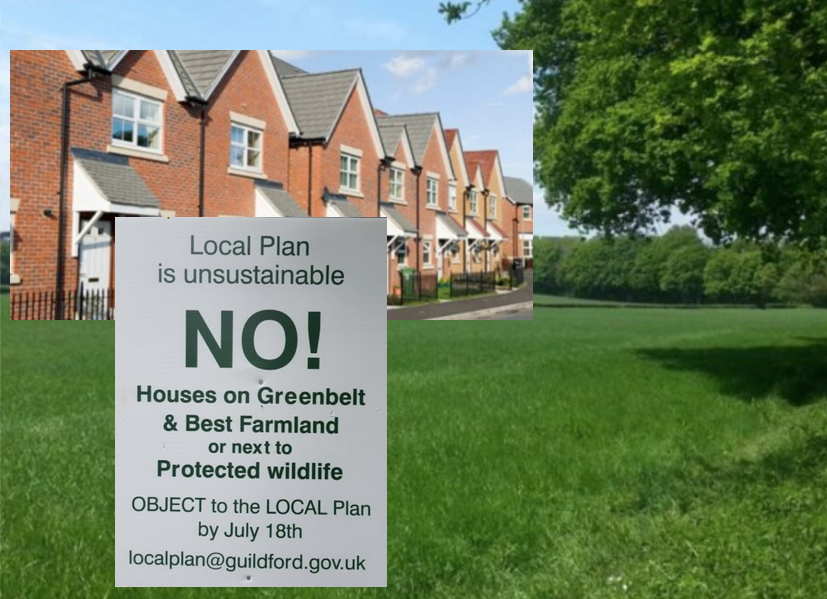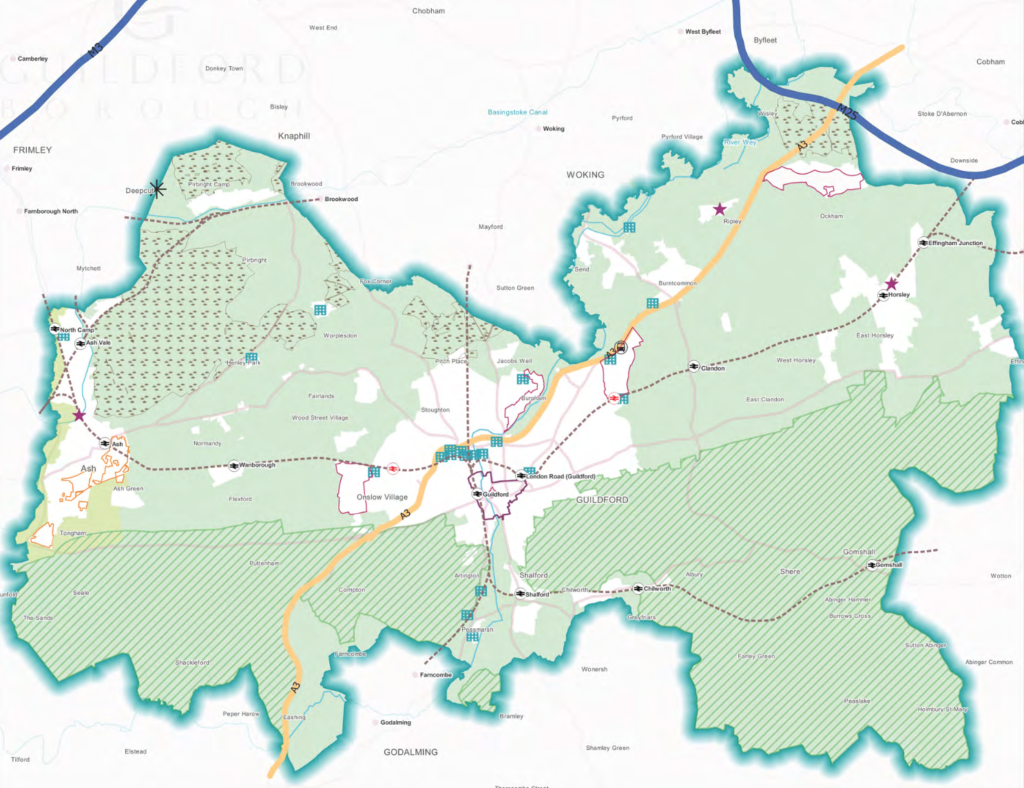 Abraham Lincoln
If given the truth, the people can be depended upon to meet any national crisis...
Abraham Lincoln
If given the truth, the people can be depended upon to meet any national crisis...
 Guildford news...
for Guildford people, brought to you by Guildford reporters - Guildford's own news service
Guildford news...
for Guildford people, brought to you by Guildford reporters - Guildford's own news service
GBC Asks Housing Minister to Reconsider Guildford’s Housing Target
Published on: 3 Oct, 2024
Updated on: 4 Oct, 2024
By Martin Giles
Guildford Borough Council has submitted its response to the Government’s consultation on proposed changes to the National Planning Policy Framework (NPPF).
At present, Guildford’s Local Plan housing target is 562 per annum but under the Government’s new proposed method for calculating housing need this figure will almost double, rising to 1,102.
In a letter addressed to Angela Rayner MP, Secretary of State for Housing, Communities and Local Government, the leader of the council, Julia McShane, and lead councillor for Planning, Fiona White, outlined the council’s position – asking the Government to reconsider Guildford’s housing target.
The letter confirmed the council’s support for a plan-led planning system but expressed concern about the proposed changes to the standard method for calculating housing need.
A planning system overhaul was one of the first measures announced by the Labour government in July by Ms Rayner as part of the new government’s pledge to deliver 1.5 million homes over the next five years.
Under the plans, some “low-quality” green belt land will be freed up to be designated “grey belt” on which new homes can be be built.
The government has previously described the grey belt as “poor quality and ugly areas” on parts of the protected green belt. One example given of grey belt is previously developed land – land that, until now, has usually been referred to as brownfield which most parties, if not all, agree should be prioritised for redevelopment.

Green belt protection has been a contentious issue locally and nationally in recent years. The sign is from 2016.
Established more than 70 years ago, the green belt covers about 13 per cent of England. After the Second World War, there was a recognition of the need to control the development of land, resulting in the Labour Government’s Town and Country Planning Act 1947, which laid the foundation of the modern planning system.
A number of the local planning authorities in and around London started writing into their local plans belts of restricted development to stop the uncontrolled spread of London. And in 1955 the then Conservative Government issued a circular to all Local Planning Authorities asking them to establish green belt areas in their Development Plans to limit the growth of large built-up areas, and to stop large towns and settlements merging into one another.
See also: Reactions to News of GBC Asking for Reconsideration of Doubled Housing Target and Dragon Interview: Lead Planning Councillor on New Housing Target Proposal
Until the current Local Plan for Guildford was adopted by the outgoing Conservative administration in May 2019, 89 per cent Guildford Borough had green belt protection but the 2019 plan removed the designation from “inset” villages and specified strategic sites such as Wisley, Gosden Hill and Blackwell Farm.
Under the Labour government’s plans, if a council’s housing targets cannot be met, some existing green belt land will be re-designated as grey belt. This will free up land for the construction of new homes.
Some believe that in order to meet increased housing targets new strategic sites may have to be designated while more high rise buildings might also be regarded as necessary.
New rules will also require half the dwellings built in the grey belt to be affordable homes.
Cllr Fiona White said: “We fully acknowledge the Government’s commitment to increasing housing delivery. We recognise that adjustments to housing numbers are needed to meet this commitment. However, it will be incredibly challenging to accommodate the level of growth requested in our borough and stronger infrastructure plans will be needed to support it.
“There are significant constraints facing Guildford. Areas are protected beyond green belt designation. These include the Surrey Hills National Landscape, the Thames Basin Heaths Special Protection Area, and sites of conservation importance. Also included are parts of the borough prone to flooding.
“We also raised concerns about speculative development applications, and the potential release of green belt land during the update period for our Local Plan.”
Cllr White added: “While the proposed changes regarding affordable and social housing are a positive step, we believe that these powers should be further enhanced.”
 The Campaign to Protect Rural England (CPRE) in Surrey has warned that the population of Surrey could grow by 40 per cent to over 1.7 million if the Government’s proposed new formula for calculating housing requirements is adopted. The charity says if imposed on local authorities the Government’s new mandatory housing targets will be hugely damaging to the environment and quality of life in Surrey.
The Campaign to Protect Rural England (CPRE) in Surrey has warned that the population of Surrey could grow by 40 per cent to over 1.7 million if the Government’s proposed new formula for calculating housing requirements is adopted. The charity says if imposed on local authorities the Government’s new mandatory housing targets will be hugely damaging to the environment and quality of life in Surrey.
Responses to GBC Asks Housing Minister to Reconsider Guildford’s Housing Target
Leave a Comment Cancel reply
Please see our comments policy. All comments are moderated and may take time to appear. Full names, or at least initial and surname, must be given.Recent Articles
- Letter: Come to Our Open Day this Saturday
- Letter: Is This the Ugliest Building in Guildford?
- Pub Chain Wins High Court Battle Over Customer’s Injuries
- Forest Management Can Influence Health Benefits
- Dragon Interview: New Guildford Mayor Howard Smith
- Delaying the Net-Zero Transition Could Have Dire Consequences, Research Reveals
- County Council Leader Appeals to MPs Not to ‘Talk Down’ Children’s Services
- Guildford Plays Its Part in Campaign to Protect Bees
- A New Superdrug is Coming to Guildford’s Ladymead Retail Park
- Two Candidates Compete for Seat on Ash Parish Council


Recent Comments
- J Howard on Stoke Mill To Be a Pub If Plans Are Approved by Borough Council
- Angela Richardson on Letter: Zero Carbon – Nothing But Hot Exhaust
- George Potter on Letter: Zero Carbon – Nothing But Hot Exhaust
- Sara Tokunaga on Letter: Zero Carbon – Nothing But Hot Exhaust
- S Collins on Stoke Mill To Be a Pub If Plans Are Approved by Borough Council
- George Potter on Letter: Zero Carbon – Nothing But Hot Exhaust
Search in Site
Media Gallery
Dragon Interview: Local Artist Leaves Her Mark At One of England’s Most Historic Buildings
January 21, 2023 / No Comment / Read MoreDragon Interview: Lib Dem Planning Chair: ‘Current Policy Doesn’t Work for Local People’
January 19, 2023 / No Comment / Read MoreA3 Tunnel in Guildford ‘Necessary’ for New Homes, Says Guildford’s MP
January 10, 2023 / No Comment / Read More‘Madness’ for London Road Scheme to Go Ahead Against ‘Huge Opposition’, Says SCC Leader
January 6, 2023 / No Comment / Read MoreCouncillor’s Son Starts Campaign for More Consultation on North Street Plan
December 30, 2022 / No Comment / Read MoreCounty Council Climbs Down Over London Road Works – Further ‘Engagement’ Period Announced
December 14, 2022 / No Comment / Read MoreDragon Interview: GBC Reaction to the Government’s Expected Decision to Relax Housing Targets
December 7, 2022 / No Comment / Read MoreHow Can Our Town Centre Businesses Recover? Watch the Shop Front Debate
May 18, 2020 / No Comment / Read More















Robin Hill
October 30, 2024 at 12:20 pm
It would be interesting to see if others agree with me that the Stoney Castle site would come under the “grey belt” classification.